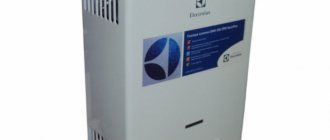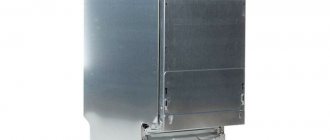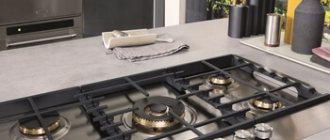Almost no kitchen is complete without an electric stove. It is thanks to this technique that every housewife has the opportunity to feed her family a delicious breakfast, lunch or dinner. There is a wide range of slabs on the market that differ in functionality, size and price. But one of the most important characteristics is the type of hob burner. There are 4 types in total. In our article we will consider in detail the type of Hi Light burners, present their main characteristics, and point out the advantages and disadvantages. We will also focus on popular models of electric stoves with such burners.
Types of heating elements of cooking surfaces
There are 4 types of burners: rapid, halogen, induction and Hi Light. Let's look at them in more detail.
Rapid burners are considered simple. Their heating element is a nichrome spiral. The hob heats up in about 12 seconds. Rapid burners have a round shape and different sizes. Electricity consumption is 1-1.5 kW/hour. Its value depends on the size of the burner.
Halogen hobs consist of a heating element in the form of a quartz gas-filled tube. You can start cooking on these burners in just 2 seconds. Electricity consumption is about 2 kW/hour.
Induction is an expensive, but at the same time the safest type of burner. Their advantage is that it is not the hob that heats up, but the bottom of the pan that sits on the stove. This reduces the risk of getting burned when cooking to a minimum. In addition, you can adjust the power as precisely as possible, which allows you to save energy. The disadvantage of induction burners is that you need to buy special cookware, and their price is too high.
It remains to find out what Hi Light burners mean. Let us consider this type of hob in as much detail as possible.
Halogen cooking surfaces
The heating process in this case is ensured by a high-temperature spiral, which is combined with a halogen lamp - hence this burner got its name. This type of stove is equipped with a gas-filled quartz tube, which is involved in heating the cookware. Such surfaces can also be distinguished by the characteristic glow of a bright red lamp, which emits more and more heat as it glows.
The advantages of a halogen surface include high power, fast heating and the same cooling. Such stoves reach their maximum power almost immediately after switching on, so you won’t have to wait long for the optimal temperature regime. Today, halogen type burners can be found in the model lines of manufacturers Bosch, Zanussi, etc.
Hi Light burners - what are they?
Another name for them is tape. Translated from English, Hi-Light is a modern fast heating element. It is used in stoves with glass-ceramic hobs. Externally, such a heating element consists of a thin spring (spiral), made of a special high-resistance (high-resistance) alloy and laid in a circle in the shape of a ribbon or snake.
If you need to quickly heat up food or prepare porridge for breakfast, Hi Light burners are ideal. What it is can be understood from the name. This is an element that provides rapid heating of the stove surface in literally 5 seconds. These burners are the most popular. Electricity consumption during their operation is 2 kW/hour.
What is usually “scaring” about induction?
For housewives, this is, first of all, the need to review the “fleet” of kitchen utensils. The principle of induction is simple and familiar to us from school physics lessons. This is the interaction of the vortex electromagnetic field, which is formed when current passes through the induction coil, and the ferromagnetic alloy of the bottom of the cookware. Heating occurs directly in the bottom due to the occurrence of induction currents. It is clear that the dishes, which play such a serious role, must be special.
In practice, everything is much simpler: the bottom is magnetic and can be used, so that a significant part of the dishes will “remain in service.” But not all of them; copper vessels for special dishes, favorite Turks for morning coffee, pressure cookers, old juice cookers, etc. are not suitable for induction.
Another point: induction is indeed an unusual thing, and therefore causes caution, because it does not involve conventional heating. What’s also scary is the potential presence of unusual sounds, clicking sounds, for example, the hum of a fan (the coils need to be cooled).
However, many buyers recognize the benefits of induction as a more efficient cooking method. Let us formulate the advantages of induction once again:
– maximum efficiency for modern types of burners – more than 90%;
– sensitive response to changes in settings, including a decrease in power, which is caused by the absence of thermal inertia characteristic of high-speed burners;
– low heating of the surface of the stove and, as a result, easier maintenance.
So it turns out that many housewives simply lack the determination to switch to induction, but they are already aware of its advantages and are ready to use them. It is for such people that hybrids become an excellent solution, which gives them the opportunity to join new technologies and at the same time reserve the right to cook in their usual favorite dishes.
Price issue
Previously, there was an opinion that induction was expensive, and models with two types of burners cost less. Now everything has changed: induction has become more accessible, and hybrids have turned out to be somewhat more significant in price.
The most budget option among hybrids - Electrolux EHG 6341 FOK costs about 12,500 rubles, which is more expensive than the cheapest fully induction panel Hotpoint-Ariston KIB 644 CE for 10,000 rubles. The situation is similar when comparing products of the same brand. The hybrid device AEG HK 634150 XB costs 18,300 rubles, solo induction AEG HK 634200 XB costs about 16,000 rubles, another pair is Bosch PIC645F17E for 16,600 rubles. and the cheapest induction from the manufacturer Bosch PKE651B17E for 13,000 rubles.
Among the non-budget solutions, the hybrid from Miele is the KM 5920, for which you will have to pay about 64,000 rubles, which is also more than for the model with four induction burners Miele KM 6115, it costs 55,450 rubles.
Who cares?
The level of interest in devices of this type is low, so the choice of hybrids is limited; there are currently about 30 models on sale. In addition, not all manufacturers are ready to produce hybrids. Bosch, Electrolux, NEFF and Siemens have the most of them. At the time of writing, Hotpoint-Ariston, Gorenje, and AEG each have two or three models.
Korting, Hansa, Zanussi, TEKA, Miele, Kuppersbusch offer just one device each. A new hybrid model is expected in DeLuxe. It is also possible that the Ardesia brand, which is still unknown in Russia, will present its models.
As it is
Hybrids - cooktops that combine induction and high-speed heating zones - come in four- and five-burner versions.
All four-zone brews have two elements of both types, that is, the zones have approximately “equal rights.” It cannot be any other way: induction burners are always placed in pairs, since they are “served” by one induction coil.
Induction zones are often assigned to the front row, thereby confirming “who’s boss.” The placement at the front has its own logic. Elements, as the most accessible, are better suited for operations in which the housewife takes maximum participation, for example, frying cutlets, pancakes or potatoes.
It is they that often require flexible changes in settings during cooking, and the home cook can slightly increase or decrease the “fire,” which induction does even better than gas burners. At the same time, Hi-Light burners in the far row are used for processes where some temperature stability is valued (the burners cool slowly) - for example, for soup, therefore, less attention of the housewife is required here.
Similar logic is used in a number of models. Here are some examples: Bosch PIC645F17E, Electrolux EHG 6341 FOK, AEG HK 634150 XB.
The second placement option is the right or left row. On the right, induction is installed in Hotpoint-Ariston KEC 647 X, Gorenje ICT 621 AC, Körting HI 6203 B, etc. On the left - Hansa BHI64373030, Master Cook I4D622S, TEKA IR 622.
For 5-zone models the situation is different. Induction is clearly preferred here; it uses 4 zones, and the 5th is either an oval Hi-Light burner or a Wok-type burner. Although the elements occupy a central place, they obviously will not be used every day, that is, they are assigned the role of a pleasant addition. There are very few models for 5 zones; at the time of writing there are only 6.
No bridge
The induction zones of hybrids are familiar burners with a certain diameter, for example, 145 and 210 mm on the AEG HK 634150 XB panel. Large areas where there is no need for reference to dimensions are not used. The Booster function is actively used to temporarily increase power.
The function allows you to borrow part of the power from one of the induction burners in order to heat the food to the required temperature on the second induction as quickly as possible. The Miele KM 5920 model has a TwinBooster function, with zone power increasing from 2.3 kW to 3.0 and 3.7 kW.
The Booster function is activated for 8-10 minutes. There is no possibility of combining existing zones into one large common zone for preparing dishes on large roasting pans (a function called Bridge).
HI-LIGHT
High-speed elements heat up quickly (5-7 seconds before the selected power) and cool down slowly. Moreover, in hybrids they have the usual attributes. This is, of course, a double circuit for using dishes of two diameters. For example, on the Gorenje ICT621AC panel, the internal small contour is 12 cm, and the external one is 18 cm. Most often, such an element is placed in the far row, as in Electrolux EHG 6341 FOK, DeLuxe VM4660129F, Korting HI 6203 B.
Fireplaces with an oval extension are quite popular, while with four-burner panels they are placed behind them, as in Siemens EH611BC1, Neff T43R20N1, AEG HK 634150 XB.
The five-burner Hi-Light, as already mentioned, only has an oval or wok and is placed exclusively in the center.
Rapid burners or Hi Light - which is better?
It is these two types of heating elements of cooking surfaces that are most often subject to comparison. They are approximately in the same price range, but in terms of performance characteristics they differ somewhat. Let's consider the main parameters of these two types of hob elements and determine which is better: rapid burners or Hi Light. Let's start with the heating speed.
The time required to heat up a rapid-type hob is 12 seconds, while on a Hi Light hob you can start cooking in just 5 seconds. This is a significant advantage, especially when it comes to rushing to prepare breakfast or dinner for children.
The second criterion is the type of heating element. In rapid burners it is a spiral, and in Hi Light it is a tightly laid corrugated tape. In the second case, the useful heating area will be larger, and accordingly the speed and efficiency will be higher.
The third criterion is design. Hi Light burners are located under a glass-ceramic hob and look stylish and modern. When working, a thin red corrugated tape is visible through the glass of the working surface of the stove. The spiral of the rapid burner most often does not hide under the panel due to the heating rate not being high enough. As a result, the slab has an unaesthetic appearance.
A supplier you can trust
If we talk about specific stores where all this can be found, then Kitchen-Service is worth special mention. This is a company that for 11 years has been pleasing its customers with only original new components from official suppliers. No analogues, used spare parts or other nuances. Burners, for example, can be serviced under warranty if the installation was initially carried out by a certified service department.
The catalog contains components of all sizes and shapes, and there are also models for other stoves. On the site you will find only the best products from American and European brands at attractive prices. If a product is missing from the catalogue, you can always order it. In addition, the store will delight you with excellent personal service.
Payment is made to a bank account, regardless of whether you are a private client or a legal entity. In both cases, you need to transfer money through the bank, after which the goods will be shipped. If you are a legal entity, then all necessary invoices, invoices and documents for the tax office will be delivered along with the spare parts. To ensure that the cargo quickly reaches the buyer, transportation is carried out in several ways. Within the city, the order will be handled by a courier, and within Russia it will be delivered by a transport service. There is also shipping to the CIS countries through international carriers.
Characteristics of Hi Light burners
The data presented below will help give a complete picture of belt-type hobs. Hi Light burners have the following characteristics:
- heating element - corrugated tape made of high-resistivity alloy;
- heating speed - 5-7 seconds;
- strong heating of the cooking surface (compared to induction cookers);
- electricity consumption - 2 kW/hour.
The key characteristic of such a heating element of the hob is speed. This is the main purpose of the Hi Light burner. What it is is clear from the name - it is a fast heating element, which has a number of advantages over induction and rapid cookers.
Halogen stove: operating principle
It got its name because of the hob with halogen burners . It may consist of only one hob or also have an electric oven, which is equipped with a halogen heating element.
Works on the principle of a halogen emitter . The heating element is a spiral-shaped quartz tube filled with bromine or iodine vapor and having a refractory spiral inside. It heats up under the influence of an electric current passing through it, begins to glow, and releases heat to heat the hob. Iodine and bromine vapors help restore the surface of the spiral, extending its service life.
The halogen burner heats up in 3-5 seconds to maximum temperature. Therefore, cooking time and energy costs are significantly reduced compared to conventional electric ovens.
The hob may have 1-4 halogen burners . It is covered with heat-resistant glass or glass ceramics and is absolutely flat. You can distinguish a halogen stove by the “H” icon (from the Latin - Halogen) on its surface.
Advantages and disadvantages
We will try to highlight the main pros and cons of the Hi Light burner.
Advantages:
- it takes a minimum of time to heat up the burner, so you can start cooking almost as quickly as on a gas stove;
- high heating speed helps to save energy, because cooking will take less time;
- short transition time from the hottest heating level to the minimum;
- It is practically not inferior in functionality to an induction hob, while it costs 2 times less;
- you don’t have to buy special cookware like for stoves with an induction heating element;
- The glass-ceramic surface is easily cleaned from plaque and dirt.
Flaws:
- the operation of the heating element directly depends on the network voltage;
- it takes some time for the burner to cool down after turning it off, unlike induction cookers, which cool down instantly;
- insufficiently high level of fire safety;
- high electricity consumption.
Disadvantages of a halogen stove
- High power consumption . A halogen stove runs on electricity. It heats up quickly, but cooking food consumes a significant amount of electricity, comparable to conventional electric ovens.
- Short service life . The service life of a halogen stove with daily use is more than 8 years. This is very little for such technology. For example, gas and conventional electric operate for more than 10 years. To extend the service life, a strip electric heater is built into the burner. First, the halogen one works for quick heating, and then the electric tape turns off and turns on.
- Demanding on cleaning conditions . Do not clean the surface with soda or products containing abrasives. They leave scratches, marks, stains. The use of rough brushes and sponges is also not recommended.
- Fragility . A sharp or heavy object dropped on the hob may cause a crack or chip. The quality of work and appearance of household appliances will deteriorate significantly.
- Special conditions of use : first place the dishes, then turn on the stove; the bottom of the dish should be smooth, dry, without adhering crumbs and traces of food; Protect the surface from contact with bulk products that melt and burn: flour, sugar, cereals.
Popular models
Let's look at the most popular electric stoves with Hi Light burners. What are these models:
- Beko HIC 64403 TX is a typical representative of electric stoves with a belt heating type. There are 4 burners on the glass-ceramic surface, one of which is oval, which makes it easy to cook a dish in a long roasting pan, and the heating will be uniform. It has touch controls, a residual heat indicator and a child lock.
- Hansa BHC63906 - a feature of this model is automatic boiling. This means that first the burner heats up to the maximum value, and then the stove switches to the initially set mode.
- Miele KM 6230 - operating modes of the burners are set using the numeric keypad. The burners heat up very quickly (the manufacturer claims 35% faster than other companies). There is a function for using residual heat and the ability to set a minimum power level.
Summarize
When deciding to purchase a halogen stove, please note:
- It can have from 1 to 4 burners , be stationary or built-in, with or without an oven. On sale you can find combined hobs: halogen and gas.
- The oven and hob can have common or separate controls.
- Prices range from 200-400 US dollars .
- A halogen stove with additional functions is more expensive than a regular one. These are: timer; water boiling control; booster; sensor that detects the presence of dishes, etc.
It is worth distinguishing a halogen cooker from an induction cooker. They are similar in appearance, but differ in the principle of heating the food being prepared. Induction heats food using electromagnetic field energy. At the same time, its hob remains cold. Special expensive utensils are used to cook food on it.
Customer Reviews
Electric stoves with glass-ceramic surfaces and Hi Light burners, according to reviews, are very popular among housewives. Buyers like the ease of use, high power, stylish design, ease of cleaning and reliability of such equipment.
In addition, some reviews noted the advantages of stoves with combination burners. They combine the functions of Hi Light and an induction hob, which is very convenient when preparing different types of dishes. The former are convenient to use if quick boiling is required, and the latter are for long-term simmering and stewing of food.
Among the disadvantages of Hi Light burners, buyers noted the high energy consumption. For many, this has become the main factor when choosing a hob.
What to look for when choosing
Today, a fairly wide range of glass-ceramic stoves are produced on the household appliances market, although they are made by several manufacturers. Halogen stoves can be tabletop or with a built-in hob. It is worth considering that built-in ones are much more expensive. The next criterion that it is recommended to pay attention to is that such slabs come in two types: dependent and independent. In dependent cookers, the controls for the oven and the surface are the same, that is, they work together.
When you understand the types of halogen stoves, consider their price category. Depending on the model and its manufacturer, the price ranges from $200 to $400. The more functional the model and the better the brand, the higher the cost of the halogen stove. There are the following additional functions:
- timer (turns off the burner automatically after a certain period of time);
- display unit (displays the temperature of the burners and oven);
- control panel lock;
- control of water boiling (heating power is reduced when the moment of boiling is determined);
- additional sealing of the oven door;
- booster (you can increase the power of one burner at the expense of others);
- a sensor that detects the presence of dishes on the surface and turns off when empty dishes are detected.
How much do Hi Light burners cost?
The price of a popular model with a glass-ceramic surface is 20 thousand rubles. This is the national average. The majority of electric stoves presented today on the domestic market have the same price. At the same time, the Hansa BHC63906 model costs much less - on average up to 10 thousand rubles. This is a budget option for a stove with a glass-ceramic surface and Hi Light burners.
The price of the Miele KM 6230 brand model is set at 130 thousand rubles. Such a stove with unique digital control is available only to a narrow circle of consumers.
Cost range
The price of the halogen panel is higher than other traditional electric stoves, but is gradually becoming more affordable due to increasing competition among retailers. A basic model with four burners will cost you about $800, and a larger unit with a complex burner design will cost around $2,500.
By the way, here is one of our previous publications https://gospodarka.ru/na-kakoy-posude-ne-stoit-ekonomit.html, where we told you what dishes you shouldn’t skimp on. Perhaps this information will also be useful to you.
Article protected by copyright and related rights. When using the material, an active link to the women's magazine gospodarka.ru is required!
And in addition to the above, we offer a small interesting video instruction on choosing a hob. Do not miss!
When choosing a suitable kitchen stove, you should take into account many subtleties: price, dimensions, electric or gas, presence of an oven, functionality, power and ease of use. If, despite all the parameters, the speed of heating or cooking food, as well as safety when using the stove, is of greatest importance, you should pay attention to halogen electric stoves.
How to choose the optimal model?
First you need to decide on the primary selection criteria. If power is at the forefront, then there will be no problems with the choice - high power potential today is characteristic of all types of hobs. Another thing is that peak power is not achieved immediately, and here the Hi Light burner type comes first, providing heating within 6 seconds. This option may also be of interest to those who appreciate the stylistic advantages of glass-ceramic panels, but are not prepared for the disadvantages of induction models. Other electric stoves should only be used due to financial limitations. Traditional stoves are cheaper, but in terms of ease of use and technical capabilities they are inferior to modern hobs.
Is gas safe?
In an hour, one burner consumes about 0.3-0.6 cubic meters of gas. A small amount of combustion products inevitably enters the air. To make it comfortable for you to work with a gas hob, it is better not to skimp on a powerful hood and make sure that the ventilation in the apartment works correctly (ventilation often suffers during unauthorized redevelopment of neighbors). Modern models of gas stoves and panels are much safer than their predecessors. Almost all of them are equipped with electric ignition. Gas control will automatically turn off a burning burner if the wind from the window blows out the flame or something goes wrong under the pan lid. There will be no gas leak!
KEEP IN YOUR VIEW:
- Gas heats not only the dishes, but also the air.
- Good ventilation and a powerful hood are a must have in a kitchen with a gas hob.
- The flame temperature of a gas burner exceeds 600 ⁰C, contact with hot dishes “in the heat of the moment” can be fatal for a composite sink or acrylic stone countertop (damage is possible at temperatures above 200 ⁰C).
Combination burners
Perhaps the most technologically advanced type of modern electric stove is a combination of two types of burners - induction and Hi Light. The now familiar four-zone configuration includes two compartments that operate on the principle of an electromagnetic field, and two panels containing high-resistivity alloy tapes. In this case, the user can extract the maximum of useful qualities that Hi Light burners offer. What is this from the point of view of the owner of a combined model? First of all, the ability to quickly heat water, boil eggs and perform other operations that require fast and maximum heat transfer. If efficiency fades into the background, then you can switch to the induction burner function, which will provide ease of use with less energy consumption.
Steel, enamel or glass ceramics?
The outer, visible surface of the hob can be made of different materials. For models with gas burners, stainless or enameled steel, tempered glass and glass ceramics are used. Models with electric heating elements are sometimes even called glass-ceramic hobs. But here both glass ceramics and tempered glass are used. It is impossible to say unequivocally which hob is better - each material has its own advantages, and they all need care after use. To preserve the appearance of the surface, drops of water and dirt must be removed immediately.
WHAT HOBS ARE AFRAID OF:
- Stainless steel is sensitive to grease, water with a high content of hardness salts and even fingerprints. For high-quality cleaning, special polishes are produced. Abrasives are prohibited.
- Enameled steel is one of the easiest materials to clean, but it is also resistant to abrasive powders, acids, and hard brushes. When heavy objects fall, chips and cracks easily form, causing irreparable damage to the surface.
- Glass ceramics are easy to maintain in perfect condition if dirt is removed immediately. In everyday life, its main enemies are hard water, which leaves a light coating, and sugar-containing liquids, for example, runaway compote or jam (frequent contact with them negatively affects the surface structure).











